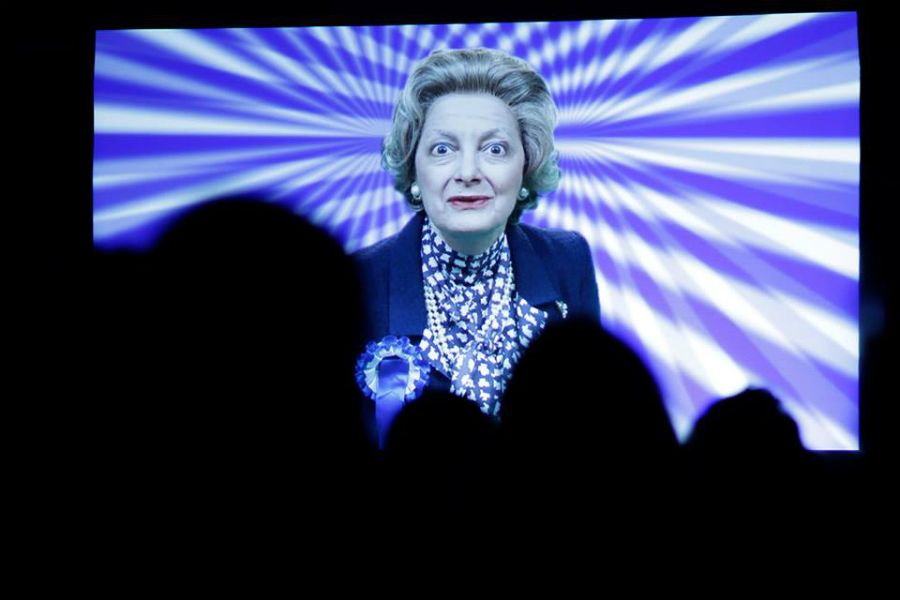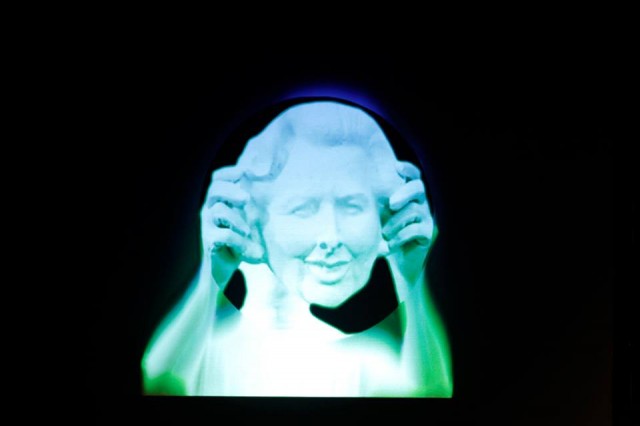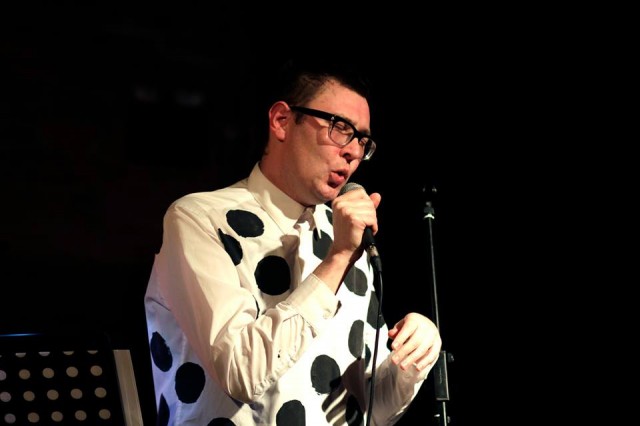“The problems of that time remain unresolved”: The Unspeakable Freedom Device — Reviewed

Jennet Thomas transports C. James Fagan back to the Thatcher years: a time of nuclear scares, managed decline and milk snatching…
Thatcher! Thatcher! Milk snatcher!
This chant has resonance with me, as Margaret Thatcher’s infamous decision to withdraw free milk from nursery schools, taken while Minister for Education in 1971, coincided with my time in nursery (although I do remember getting milk to drink). Since then, Thatcher has occupied a part of mine and many others’ lives as a narrative permeating British culture; usually portrayed as a presence that borders on the supernatural, helped in part by various depictions of her as demon or a robot.
Like Raymond Briggs’ drawings of her in The Tin Pot Foreign General and the Old Iron Woman, or that Spitting Image sketch where she turns out to be a Xenomorph for the Alien films. When she stepped down as Prime Minister in the 1990s while I was at high school, my Maths teacher cheerfully announced: “Thatcher’s Gone!” The class cheered as if a dragon had been slain or the Death Star had been destroyed.
It is, of course, a one-sided narrative; one that came from people who opposed the materialistic, capitalistic rhetoric she espoused. Obviously people agreed with her, or sided with the idea of what she was saying; it happens I don’t count myself as one of those people.
Thatcher happens to be on my mind as I’m heading towards a screening of Jennet Thomas’ The Unspeakable Freedom Device at the International Anthony Burgess Foundation, hosted by The Exhibition Centre for the Life and Use of Books, Manchester. I’m not entirely sure what role, if any, that Thatcher plays in the film: expectations of Thatcher is based on the appearance of a look-a-like in some publicity stills.
During a brief presentation by Thomas herself, the artist explains that the flashpoint for the making of this film was Thatcher’s death and funeral. These events served to stimulate the feelings that Thomas had during the 1980s, describing what unfolded as a ‘Thatcher aesthetic’.

When The Unspeakable Freedom Device film starts, it becomes clear what that aesthetic is. Visually, it could be likened to Derek Jarman’s Jubilee (1978) or within the more satirical aspects of 2000AD strips (Nemesis the Warlock Vol. 9 springs to mind). Even in the first edgier stories of Doctor Who, for example The Sunmakers (1977).
It is in Thomas’ primitive-futuristic costumes, which echo the fear of the return of barbarism as an result of a nuclear war. It is in the discarded buildings of the sixties and seventies that form the remains of a world left to managed decline. It is in the landscape of a pleasant and green land that bears the scars of its history.
In this landscape travel two people: one a young mother on a pilgrimage for the fabled ‘Blue Lady’ (Thatcher); the other an older women who carry’s a weary wisdom regarding the young mother’s claims of the messianic qualities of this Blue Lady. These characters are helped, hindered or manipulated by creatures of Red, Blue and Green, who themselves are the echoes of past political ideals. It’s a classic sci-fi trope where the beliefs or notions of the now attain a mythical status.
As the film approaches a kind of climax at Blackpool’s Winter Gardens — which Thomas regards as the ‘origin of Thatcher’ — the two central characters join a Thatcher cult where the individuals dress like her regardless of gender. They applaud the platitudes of a Blue Man, who speaks in soundbites and jingles. Pretty much like many politicians do, leaving us to choose leaders on the basis of ‘I like the sound of that’.

This finale seems to point towards the idea of a fallacy of party politics, especially when many politicians main aim is to get into power. That most political rhetoric deals with the manipulation of symbols, the devolving of complex issues into the battleground of us and them, and the delivering of empty promises. It even expands into the narratives that the Tories are evil.
During the climax, there are moments where Red and Green forcibly join with Blue to create a possible utopian power elite. Think of the conclusion of Jim Henson’s Dark Crystal (1982). It’s strange to reflect that an exhibition of this film and of Thomas’ work was postponed by Conservative members of Blackpool council because of perceived political basis.
The film comes to a cyclical ending. There’s a break and Part Two starts.
Composer Leo Chadburn (aka Simon Bookish) steps up, having supplied the soundtrack for The Unspeakable Freedom Device. Though he’s not here to simply recreate the music we’ve just heard, rather he presents a separate yet thematically connected work entitled Red & Blue.
Red & Blue, Chadburn informs us, was inspired by his boyhood memories of seeing images of Thatcher and Ronald Reagan on the TV. He infuses these memories with transcripts of conversations between Maggie and Ronald. The 17 minutes of Chadburn’s piece unfolds like a ballad, exploring their so-called ‘special relationship’; declarations of affection wrapped around terrifying statistics regarding ICBM deployment.
Again, here is the ‘Thatcher aesthetic’: the way the ideals of that age affected the creative output of generations. It also expands into Chadburn’s other work; after Red & Blue he performs songs based on dreams of transportation. I say it expands; what I mean is that there’s something in the music that makes recall, and this may be damming with faint praise. It recalls that part of the ’80s where performance artist and musician Laurie Anderson could be Number Two in the charts alongside stuff like this.
As the last sounds fade and I ready to leave, I begin to think about the night as a whole. I begin to consider that both sections of the night were about memory and experience. Both Thomas and Chadburn have memories of a time which, when reproduced, leave a nagging, unavoidable sense that the problems of that time still remain unresolved.
C. James Fagan
Read more coverage on Thomas’ The Unspeakable Freedom Device here





